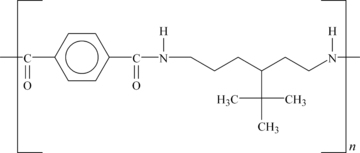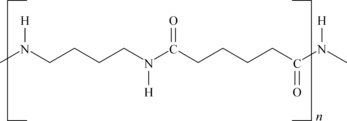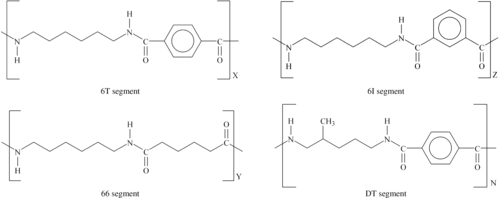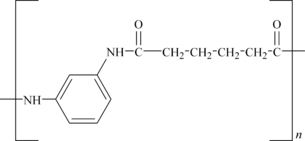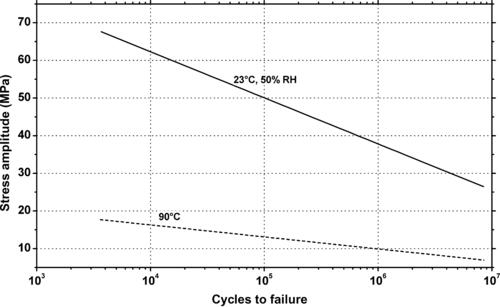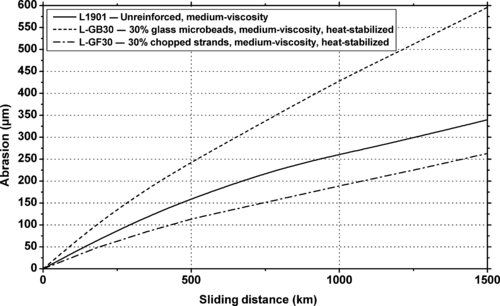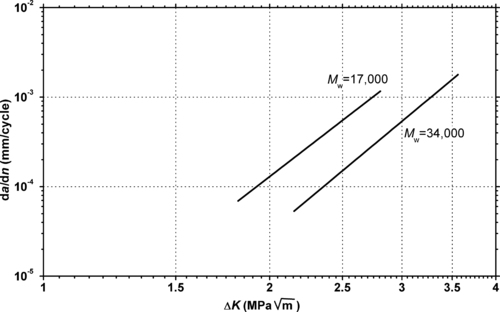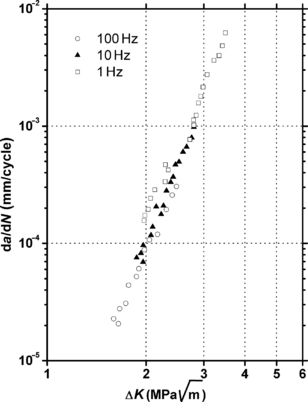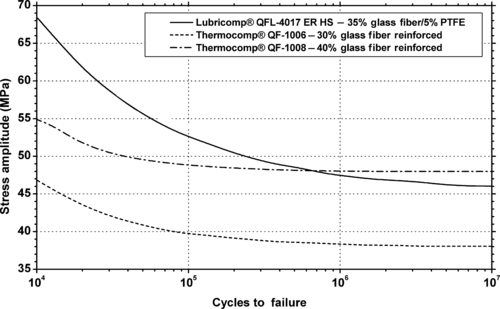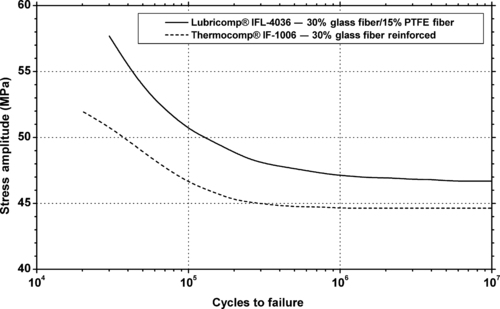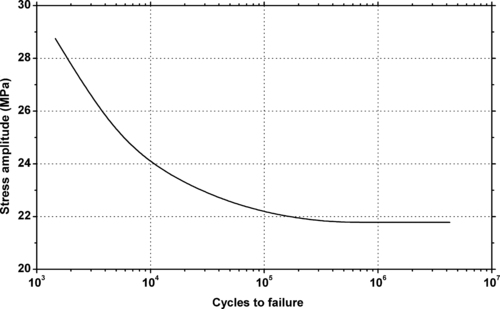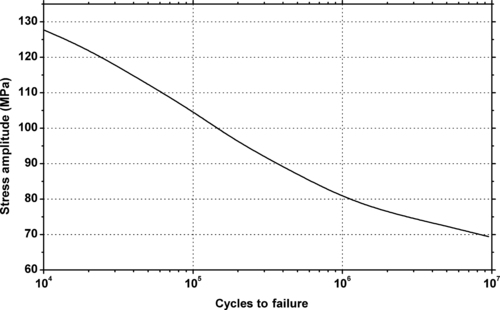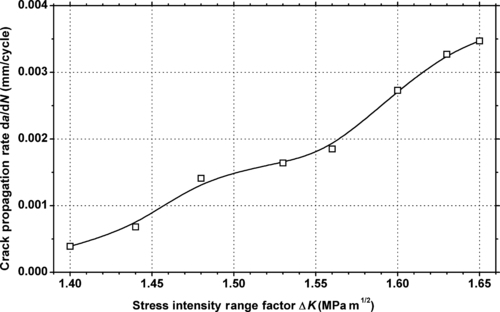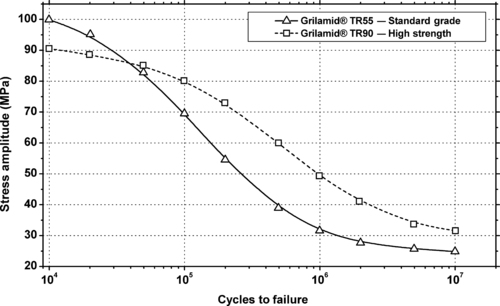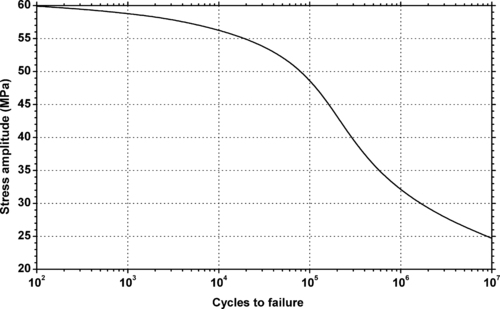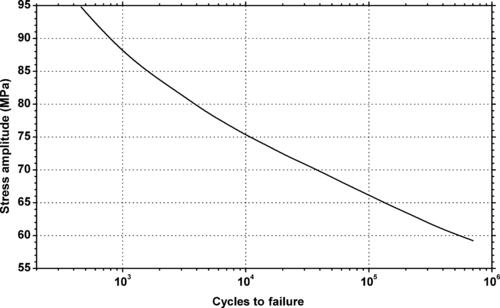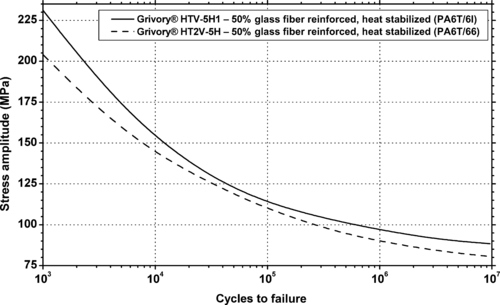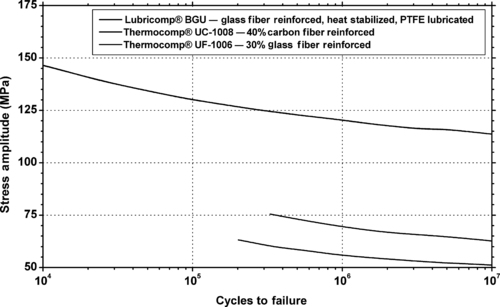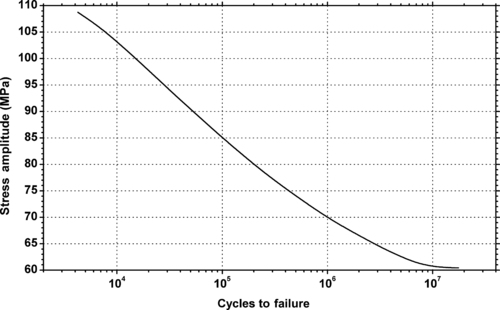Chapter 8. Polyamides (Nylons)
8.1. Background
High-molecular-weight polyamides are commonly known as nylon. Polyamides are crystalline polymers typically produced by the condensation of a diacid and a diamine. There are several types and each type is often described by a number, such as Nylon 66 or Polyamide 66 (PA66). The numeric suffixes refer to the number of carbon atoms present in the molecular structures of the amine and acid, respectively (or a single suffix if the amine and acid groups are part of the same molecule).
The polyamide plastic materials discussed in this book and the monomers used to make them are given in Table 8.1.
The general reaction is shown in Figure 8.1.
The –COOH acid group reacts with the –NH2 amine group to form the amide. A molecule of water is given off as the nylon polymer is formed. The properties of the polymer are determined by the R and R′ groups in the monomers. In Nylon 6, 6, R′ = 6C and R = 4C alkanes, but one also has to include the two carboxyl carbons in the diacid to get the number it designates to the chain.
The structures of these diamine monomers are shown in Figure 8.2, the diacid monomers are shown in Figure 8.3. Figure 8.4 shows the amino acid monomers. These structures only show the functional groups, the CH2 connecting groups are implied at the bond intersections.
All polyamides tend to absorb moisture which can affect their properties. Properties are often reported as DAM (dry as molded) or conditioned (usually at equilibrium in 50% relative humidity at 23°C). The absorbed water tends to act like a plasticizer and can have a significant effect on the plastics properties.
8.1.1. Nylon 6
Nylon 6 begins as pure caprolactam which is a ring structured molecule. This is unique in that the ring is opened and the molecule polymerizes with itself. Since caprolactam has 6 carbon atoms, the nylon that it produces is called Nylon 6, which is nearly the same as Nylon 66 described in Section 8.1.5. The structure of Nylon 6 is shown in Figure 8.5 with the repeating unit in the brackets.
Some of the Nylon 6 characteristics:
• Outstanding balance of mechanical properties
• Outstanding toughness in equilibrium moisture content
• Outstanding chemical resistance and oil resistance.
• Outstanding wear and abrasion resistance
• Almost all grades are self-extinguishing. The flame-resistant grades are rated UL 94VO
• Outstanding long-term heat resistance (at a long-term continuous maximum temperature ranging between 80°C and 150°C)
• Grades reinforced with glass fiber and other materials offer superior elastic modulus and strength
• Offers low gasoline permeability and outstanding gas barrier properties
• Highest rate of water absorption and highest equilibrium water content (8% or more)
• Excellent surface finish even when reinforced
• Poor chemical resistance to strong acids and bases
8.1.2. Nylon 11
Nylon 11 has only one monomer, aminoundecanoic acid. It has the necessary amine group on one end and the acid group on the other. It polymerizes with itself to produce the polyamide containing 11 carbons between the nitrogen of the amide groups. Its structure is shown in Figure 8.6.
Some of the Nylon 11 characteristics:
• Low water absorption for a nylon (2.5% at saturation)
• Reasonable UV resistance
• Higher strength
• Ability to accept high loading of fillers
• Better heat resistance than Nylon 12
• More expensive than Nylon 6 or Nylon 6/6
• Relatively low impact strength
8.1.3. Nylon 12
Nylon 12 has only one monomer, aminolauric acid. It has the necessary amine group on one end and the acid group on the other. It polymerizes with itself to produce the polyamide containing 12 carbons between the two nitrogen atoms of the two amide groups. Its structure is shown in Figure 8.7.
The properties of semicrystalline polyamides are determined by the concentration of amide groups in the macromolecules. Polyamide 12 has the lowest amide group concentration of all commercially available polyamides thereby substantially promoting its characteristics:
• Lowest moisture absorption (∼2%): Parts show largest dimensional stability under conditions of changing humidity
• Exceptional impact and notched impact strength, even at temperatures well below the freezing point
• Good to excellent resistance against greases, oils, fuels, hydraulic fluids, various solvents, salt solutions and other chemicals
• Exceptional resistance to stress cracking, including metal parts encapsulated by injection molding or embedded
• Excellent abrasion resistance
• Low coefficient of sliding friction
• Noise and vibration damping properties
• Good fatigue resistance under high-frequency cyclical loading condition
• High processability
• Expensive
• Lowest strength and heat resistance of any polyamide unmodified generic
8.1.4. Nylon 66
The structure of Nylon 66 is shown in Figure 8.8.
Some of the Nylon 66 characteristics:
• Outstanding balance of mechanical properties
• Outstanding chemical resistance and oil resistance
• Outstanding wear and abrasion resistance
• Almost all grades are self-extinguishing. The flame-resistant grades are rated UL 94VO
• Outstanding long-term heat resistance (at a long-term continuous maximum temperature ranging between 80°C and 150°C)
• Grades reinforced with glass fiber and other materials offer superior elastic modulus and strength
• Offers low gasoline permeability and outstanding gas barrier properties
• High water absorption
• Poor chemical resistance to strong acids and bases
8.1.5. Nylon 610
The structure of Nylon 610 is given in Figure 8.9.
Some of the Nylon 610 characteristics:
• Outstanding suppleness and impact strength at low temperature
• Relatively low hygroscopic properties
• Outstanding flex fatigue properties
8.1.6. Nylon 612
The structure of Nylon 612 is given in Figure 8.10.
Some of the Nylon 612 characteristics:
• High-impact strength
• Very good resistance to greases, oils, fuels, hydraulic fluids, water, alkalis, and saline
• Very good stress cracking resistance, even when subjected to chemical attack and when used to cover metal parts
• Low coefficients of sliding friction and high abrasion resistance, even when running dry
• Heat deflection temperature (melting point nearly 40°C higher than Nylon 12)
• Tensile and flexural strength
• Outstanding recovery at high wet strength
8.1.7. Nylon 666 or 66/6
This is the name given to copolyamides made from PA6 and PA66 building blocks. A precise structure cannot be drawn.
8.1.8. Amorphous Nylon
Amorphous nylon is designed to give no crystallinity to the polymer structure. One such amorphous nylon is shown in Figure 8.11.
The tertiary butyl group attached to the amine molecule is bulky and disrupts this molecule’s ability to crystallize. This particular amorphous nylon is sometimes designated at Nylon 6-3-T. Amorphous polymers can have properties that differ significantly from crystalline types, one of which is optical transparency.
Some of the amorphous nylon characteristics:
• Crystal-clear, high optical transparency
• High mechanical stability
• High heat deflection temperature
• High-impact strength
• Good chemical resistance compared to other plastics
• Good electrical properties
• Low mold shrinkage
8.1.9. Nylon 46
The structure of Nylon 46 is given in Figure 8.12.
Some of the Nylon 46 characteristics:
• Higher heat distortion temperature than Nylon 6 or Nylon 6/6
• Higher crystallinity than Nylon 6 or Nylon 6/6
• Better chemical resistance, particularly to acidic salts
• Similar moisture absorption to Nylon 6/6, but dimensional increase is less
• High processing temperature
• Highest mechanical properties at high temperatures
• Excellent resistance to wear and low friction
• Outstanding flow for easy processing
8.1.10. Polyphthalamide (PPA)/High-Performance Polyamide
As a member of the nylon family, it is a semicrystalline material composed from a diacid and a diamine. However, the diacid portion contains at least 55% terephthalic acid (TPA) or isophthalic acid (IPA). TPA and IPA are aromatic components which serve to raise the melting point, glass transition temperature, and generally improve chemical resistance versus standard aliphatic nylon polymers. The structure of the polymer depends on the ratio of the diacid ingredients and the diamine used and varies from grade to grade. The polymer usually consists of mixtures of blocks of two or more different segments, four of which are shown in Figure 8.13.
Some of the PPA characteristics:
• Very high heat resistance
• Good chemical resistance
• Relatively low moisture absorption
• High strength or physical properties over a broad temperature range
• Not inherently flame retardant
• Requires good drying equipment
• High processing temperatures
8.1.11. PAA—Polyarylamide
Another partially aromatic high-performance polyamide is polyarylamide, PAA. The primary commercial polymer, PAMXD6, is formed by the reaction of m-xylylenediamine and adipic acid giving the structure shown in Figure 8.14. It is a semicrystalline polymer.
• Very high rigidity
• High strength
• Very low creep
• Excellent surface finish even for a reinforced product even with a high glass fiber content
• Ease of processing
• Good dimensional stability
• Slow rate of water absorption
Graphs of multipoint properties of polyamides as a function of temperature, moisture, and other factors are given in the following sections. Because the polyamides do absorb water, and that affects the properties, some of the data are dry, or better dry as molded. Some of the data are for conditioned specimens; they have reached equilibrium water absorption from 50% relative humidity at 23°C.
8.1.12. PACM 12—Semicrystalline Polyamide
PACM 12 is a polyamide produced from bis(p-aminocyclohexyl)methane (54% trans–trans) and dodecanedioic acid. The structure is shown in Figure 8.15.
PACM 12 combines the chemical resistance of semicrystalline materials with the advantages of amorphous, UV-resistant materials. The properties of PACM 12 are:
• Crystal-clear, permanent transparency
• Superior chemical and stress cracking resistance
• High level of UV resistance
• Low water absorption compared with many other polyamides, which leaves the mechanical properties virtually unaffected
• High dimensional stability
• Balanced mechanical property profile
• High-impact resistance, even at low temperatures
• Abrasion and scratch resistance
• High glass transition temperature
• Easy processing
8.2. Polyamide 6 (Nylon 6)
8.2.1. Fatigue Data
 |
| Figure 8.16. |
| Stress amplitude vs. cycles to failure of two BASF Ultramid® glass fiber reinforced PA6 plastics. |
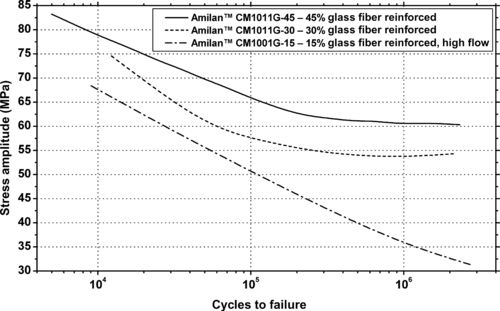 |
| Figure 8.17. |
| Flexural stress amplitude vs. cycles to failure of Toray Resin Company Amilan™ PA6 plastics. |
 |
| Figure 8.18. |
| Flexural stress amplitude vs. cycles to failure of EMS-GRIVORY Grilon® PV-5H—50% glass fiber reinforced, UV stabilized, high flow PA6. |
 |
| Figure 8.19. |
| Flexural stress amplitude vs. cycles to failure under various conditions of Toray Resin Company Amilan™ CM1011G-45—45% glass fiber reinforced standard grade PA6. |
8.2.2. Tribology Data
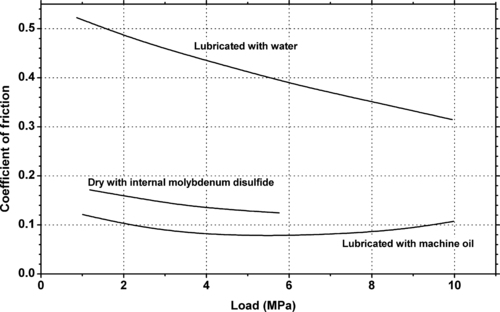 |
| Figure 8.22. |
| Coefficient of friction vs. load under different lubrication conditions of Toray Resin Company Amilan™ CM1021—unreinforced, medium viscosity PA6. |
8.3. Polyamide 12 (Nylon 12)
8.3.1. Fatigue Data
8.3.2. Tribology Data
 |
| Figure 8.25. |
| Dynamic coefficient of friction vs. bearing pressure of Evonik Industries Vestamid® L1901—unreinforced, medium viscosity PA12. |
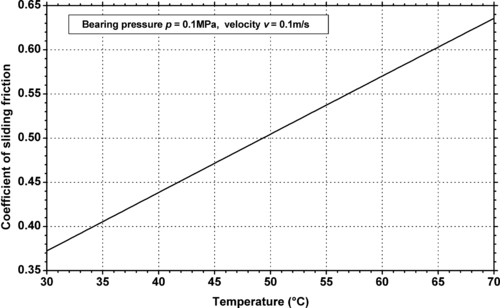 |
| Figure 8.26. |
| Dynamic coefficient of friction vs. bearing temperature of Evonik Industries Vestamid® L1901—Unreinforced, medium viscosity PA12. |
8.4. Polyamide 66 (Nylon 66)
8.4.1. Fatigue Data
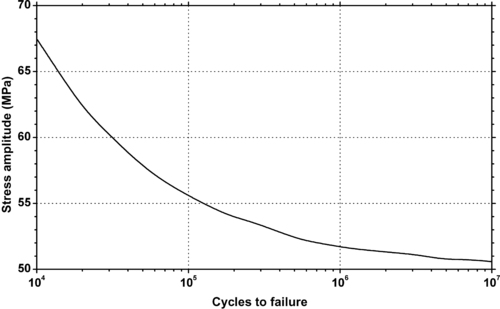 |
| Figure 8.28. |
| Flexural stress amplitude vs. cycles to failure of SABIC Innovative Plastics LNP Lubriloy® FR-40—40% glass fiber reinforced, lubricated PA66. |
 |
| Figure 8.29. |
| Flexural stress amplitude vs. cycles to failure at 23°C of two DuPont Engineering Plastics Minlon® mineral filled PA66 plastics. |
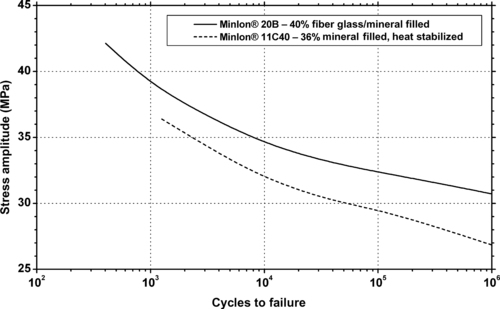 |
| Figure 8.30. |
| Flexural stress amplitude vs. cycles to failure at 23°C of two DuPont Engineering Plastics Minlon® filled PA66 plastics. |
 |
| Figure 8.31. |
| Flexural stress amplitude vs. cycles to failure at 23°C of several SABIC Innovative Plastics LNP Thermocomp® carbon fiber reinforced PA66 plastics. |
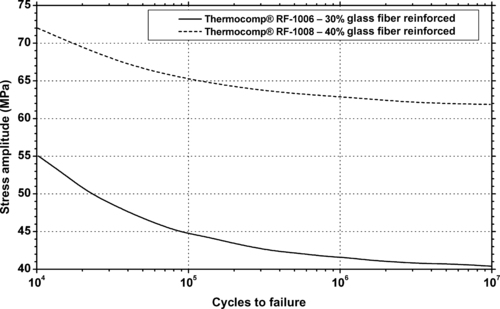 |
| Figure 8.32. |
| Flexural stress amplitude vs. cycles to failure at 23°C of two SABIC Innovative Plastics LNP Thermocomp® glass fiber reinforced PA66 plastics. |
 |
| Figure 8.33. |
| Flexural stress amplitude vs. cycles to failure at 23°C of two BASF Ultramid® glass fiber reinforced PA66 plastics. |
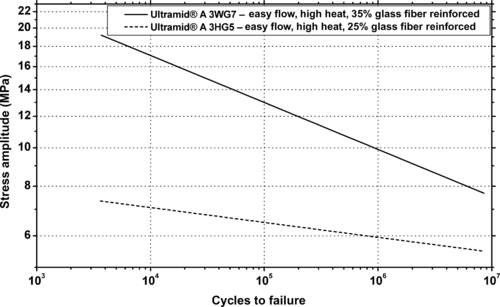 |
| Figure 8.34. |
| Flexural stress amplitude vs. cycles to failure at 90°C of two BASF Ultramid® glass fiber reinforced PA66 plastics. |
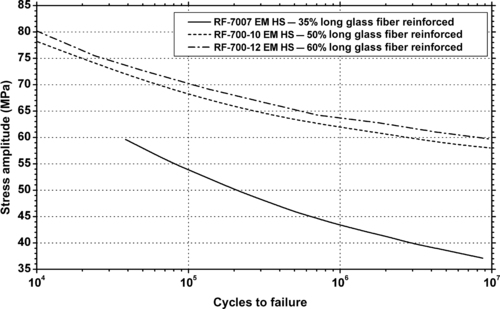 |
| Figure 8.35. |
| Flexural stress amplitude vs. cycles to failure at 23°C of three SABIC Innovative Plastics LNP Verton® long glass fiber reinforced PA66 plastics. |
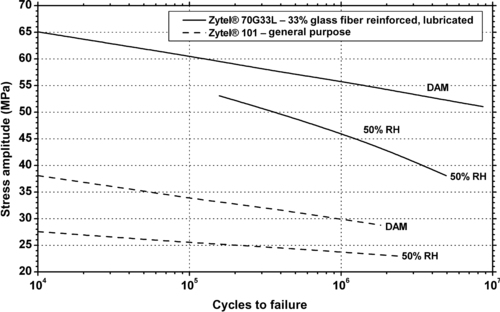 |
| Figure 8.36. |
| Flexural stress amplitude vs. cycles to failure at 23°C (conditioned and dry as molded) of two DuPont Engineering Plastics Zytel® PA66 plastics. |
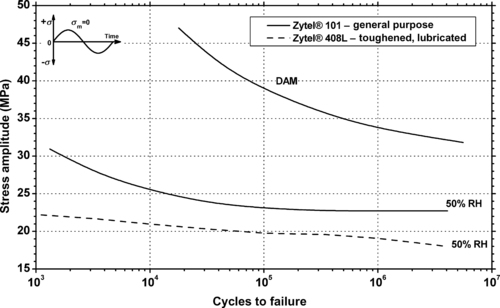 |
| Figure 8.37. |
| Axial tension/compression stress amplitude vs. cycles to failure at 23°C (conditioned and dry as molded) of two DuPont Engineering Plastics Zytel® PA66 plastics. |
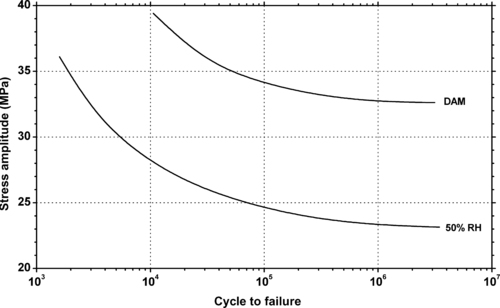 |
| Figure 8.38. |
| Flexural stress amplitude vs. cycles to failure at 23°C (conditioned and dry as molded) DuPont Engineering Plastics Zytel® 101—general-purpose PA66. |
 |
| Figure 8.39. |
| Axial stress amplitude vs. cycles to failure at different temperatures of conditioned DuPont Engineering Plastics Zytel® 101—general-purpose PA66. |
 |
| Figure 8.40. |
| Fatigue crack propagation rate vs. stress intensity factor of DuPont Engineering Plastics Zytel® 122L PA66. |
8.4.2. Tribology Data
 |
| Figure 8.43. |
| Coefficient of friction vs. load (lubricated with water) of Toray Resin Company Amilan® CM3001N—unreinforced, standard grade PA66. |
8.5. Polyamide 610 (Nylon 610)
8.5.1. Fatigue Data
8.6. Polyamide 612 (Nylon 612)
8.6.1. Fatigue Data
8.6.2. Tribology Data
8.7. Polyamide 666 (Nylon 666)
8.8. Amorphous Polyamide
8.9. Polyamide 46 (Nylon 46)
8.10. PPA/High-Performance Polyamide
8.10.1. Fatigue Data
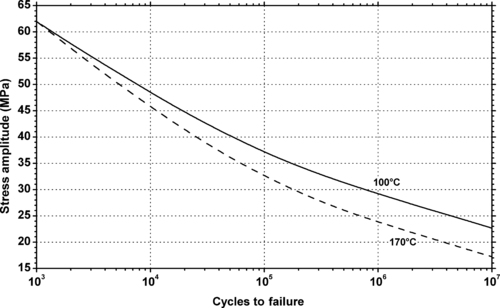 |
| Figure 8.52. |
| Flexural stress amplitude vs. cycles to failure and temperature of Solvay Amodel® A-1145 HS—45% glass fiber reinforced, heat-stabilized PAA. |
 |
| Figure 8.53. |
| Flexural stress amplitude vs. cycles to failure at 23°C and 32Hz of Solvay Amodel® glass fiber reinforced, heat-stabilized PAA plastics. |
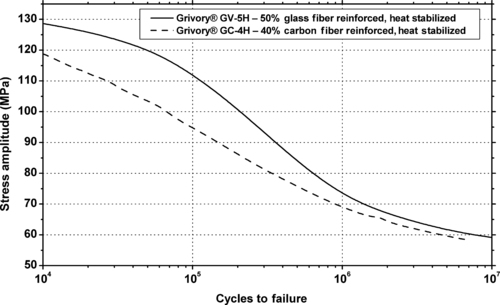 |
| Figure 8.54. |
| Flexural stress amplitude vs. cycles to failure at 23°C and 8Hz of conditioned EMS-GRIVORY Grivory® fiber reinforced PAA plastics. |
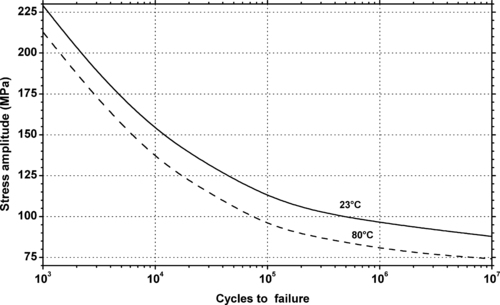 |
| Figure 8.55. |
| Flexural stress amplitude vs. cycles to failure at 23°C and 80°C of EMS-GRIVORY Grivory® HTV-5H1—50% glass fiber reinforced, heat-stabilized (PA6T/6I) PAA. |
..................Content has been hidden....................
You can't read the all page of ebook, please click here login for view all page.











